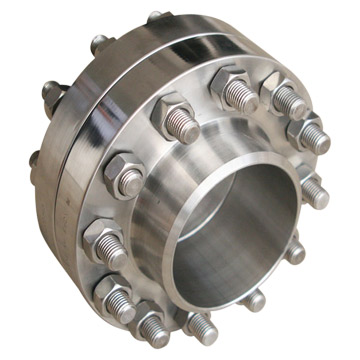

When designing or maintaining piping systems in industrial, chemical, oil & gas, or power generation environments, ASME B16.5 is the defining standard for pipe flanges and flanged fittings. Covering flanges from ½” through 24” nominal pipe size (NPS), this standard specifies flange dimensions, pressure-temperature ratings, tolerances, materials, facing types, and bolting.
This article provides an in-depth look at the common types of ASME B16.5 flanges, their material grades, and technical selection considerations to help engineers and procurement teams make informed decisions.
ASME B16.5 Flange Types
Each flange type is designed for specific system conditions, including pressure class, temperature, media, and ease of assembly or disassembly. Below are the primary flange styles defined in ASME B16.5:
1. Weld Neck (WN) Flanges
-
Features: Long tapered hub, beveled end for butt welding
-
Best For: High-pressure and high-temperature systems
-
Technical Benefit: Provides excellent stress distribution through the neck and into the pipe
-
Typical Applications: Refineries, power plants, offshore platforms
2. Slip-On (SO) Flanges
-
Features: Pipe slides into the flange bore and is fillet-welded on both sides
-
Best For: Low- to moderate-pressure services
-
Technical Benefit: Easier alignment and installation; lower cost than weld necks
-
Note: Not recommended where fatigue loading is expected
3. Blind (BL) Flanges
-
Features: A Solid disk used to close the end of a piping system
-
Best For: Testing, future expansion, system isolation
-
Technical Benefit: Can be drilled and tapped for NPT connections or instrumentation
-
Common Use: Pipe terminations
4. Socket Weld (SW) Flanges
-
Features: Pipe is inserted into the socket and fillet-welded only on the outside
-
Best For: Small-bore, high-pressure applications
-
Note: Internal crevice can trap fluids, not ideal for corrosive or hygienic services
5. Threaded (TH) Flanges
-
Features: Pipe screws into the threaded bore of the flange
-
Best For: Non-welded systems
-
Limitations: Suitable only for lower pressure and temperature applications
6. Lap Joint (LJ) Flanges
-
Features: Used with a stub end; flange floats freely around the pipe
-
Best For: Systems requiring frequent disassembly and misaligned flanges
-
Advantage: Cost savings on expensive alloys, typically, only the stub end needs to be high-grade
Pressure Classes (Ratings)
ASME B16.5 defines seven pressure classes based on material and design temperature:
-
Class 150
-
Class 300
-
Class 400
-
Class 600
-
Class 900
-
Class 1500
-
Class 2500
Each class corresponds to a pressure-temperature rating table that varies by material group (as defined in ASME B16.5 and ASME B31.3). These ratings should be reviewed carefully during specification.
Common Flange Materials
Choosing the right material depends on the system media, corrosion environment, temperature, and pressure.
1. Carbon Steel
-
A105 – Forged carbon steel for ambient to moderately high temps
-
A350 LF2 – Low-temp carbon steel (to -50°F) for cryogenic service
-
A694 F52 / F60 / F65 – High-strength, high-pressure applications (pipeline, oil & gas)
2. Stainless Steel
-
304 / 304L – General corrosion resistance; L-grade has lower carbon for weldability
-
316 / 316L – Enhanced corrosion resistance (chlorides, chemicals)
-
317L / 321 / 347 – For highly corrosive or high-temp applications (e.g., thermal cycling)
3. Alloy Steel
-
A182 F11, F22, F91 – Chrome-Moly steels for high-temperature service (used in refineries and power generation)
-
Designed for steam lines, superheaters, and high-pressure boiler systems
4. Nickel Alloys
-
Alloy 20 – Sulfuric acid service
-
Monel® 400 – Excellent resistance to seawater and hydrofluoric acid
-
Inconel® 600/625 – Oxidation resistance and high strength at elevated temperatures
-
Hastelloy® C276 / C22 – For aggressive chemical and acidic environments
5. Duplex & Super Duplex Stainless
-
2205, 2507 – Superior pitting and crevice corrosion resistance; high strength
-
Ideal for offshore, chemical, and desalination projects
6. Non-Ferrous Metals
-
Aluminum – Lightweight, non-sparking
-
Bronze – Seawater systems and aesthetic plumbing applications
Facing Types
ASME B16.5 flanges are also defined by the type of sealing surface, which must match the gasket type:
-
Raised Face (RF) – Most common; allows for various gasket types
-
Flat Face (FF) – Used with cast iron or non-metallic flanges; prevents overstress
-
Ring-Type Joint (RTJ) – Requires a metal gasket; excellent under extreme pressure
-
Tongue & Groove / Male & Female – Used in special sealing applications; not as common in standard industrial systems
Bolting and Gaskets
B16.5 also provides guidance on:
-
Bolt circle diameter (BCD)
-
Number and size of bolts per class and NPS
-
Gasket dimensions and types — spiral wound, ring joint, full-face, etc.
Always ensure flange material and gasket compatibility with system media and temperature.
Summary
ASME B16.5 flanges are essential components in pressure piping systems. The right choice of flange type, material, facing, and pressure class ensures long-term integrity, safety, and code compliance.
At Hayward Pipe & Supply Co., we stock a wide range of B16.5 flanges in carbon steel, stainless, alloy, and exotic materials, ready to meet your project’s pressure, temperature, and corrosion demands.
Need Help Specifying the Right Flange?
We’re here to assist with:
✔ Technical selection
✔ MTRs & certification
✔ Custom machining & bore matching
✔ Domestic, DFAR, AML & import options

